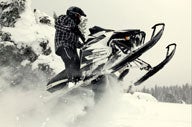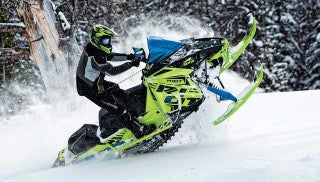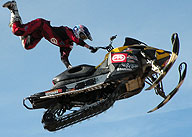2013 Arctic Cat ProClimb XF1100 Turbo Sno Pro High Country Review

Trail friendly, powder compliant, and flat out fast
It all comes down to three decisions, mountain, trail or both. I don’t have the moolah to buy three snowy giddy up machines, so I settle on one – mountain. Yet, give me a crossover and I’ll be a happy flatlander breaking trail and chucking down some deep snow in the high mountain meadows outside my home.
Engine Type:Horizontal In-line
Cylinders:2
Engine Stroke:4-Stroke
Valve Configuration:OHV
Displacement:1056 / 64.4
Starter:Electric
Turbocharged:Yes
View Full SpecOne bazooka-type weapon to shoot down the trails and mountains as a crossover is Arctic Cat’s ProClimb XF1100 Turbo Sno Pro High Country. Arctic Cat builds and delivers two crossover breeds, one built on the ProCross chassis, the other built on the ProClimb chassis. While at West Yellowstone this past March, we spent much throttle time on the ProClimb High Country, both the Sno Pro and Sno Pro Limited; the only two available High Country models from Cat this season. Both High Country models are supersleds with arm stretching, eye ball twitching speed and power.
To eliminate confusion, Cat’s XF1100, be it a CrossTour, Sno Pro Limited, Sno Pro or LXR, are ProCross specific crossovers that are powered by the non-turbocharged 1100 four-stroke twin that has 120 horsepower. The High Country models are powder-oriented ProClimbs and use turbochargers on the 1100cc four-stroke.
The High Country looks like an M1100, from its four-post handlebar tower to its mountain grab strap, long tunnel and deep-lugged track. Though it has an M1100 persona, it also has XF ProCross genes. As mentioned, the High Country (I like that name) uses Cat’s 177-horsepower turbocharged twin-cylinder four-stroke motor. The 1056cc twin is an electronic fuel-injected motor that rolls out 121 foot-pounds of torque at 7300 RPM and holds its torque steady through its upper RPM powerband.
As with the mountain-specific M1100 Sno Pro Turbo, the High Country has tall one-piece forged aluminum spindles that can take the abuse from trail and tree. The tall Fox Float shocks are aligned with the front spars to keep impact energy at the upper spar and not directed up to the handlebars.
The rear suspension is Cat’s FasTrack with coupling blocks that gives the suspension a nice cushy comfortable ride when floating along the trails at a moderate speed. But when the driver needs to attack the terrain, the FasTrack becomes not so mild mannered, but serious minded about keeping the driver and that big four-stroke supersled alive in the meadows, trees and boonies.
For knowledge sake, the M1100 turbo Sno Pro uses Cat’s M rear suspension, not the FasTrack. Also, the High Country’s front end ski stance is adjustable from 42-43 inches, whereas the M1100 is narrower at 38-39 inches. The High Country uses a sway bar on its front end, where the M1100 does not.
The High Country and the M1100 both use Cat’s Power Claw track, with the High Country’s lug height limited to 2.25 inches. The High Country’s track length is 141 inches, where the M1100 is 162 inches with 2.6-inch lugs. That is a difference of 21 inches between the two models, and a half-inch in lug height.
This is what I learned about the High Country as I jumped from it to its longer brother the M1100. The High Country’s 177 horsepower spins the 141-inch Power Claw track with such speed that without the High Country’s weight, the snowmobile would sit in one place. I’m an anti-weight person, but have learned weight can be a benefit when the horsepower nears double-century numbers and the track is short. I must give credit to the Power Claw track. It handles the boosted horsepower with skill. The FasTrack rear skid controlled the horsepower and torque with ease, keeping weight transfer – the rocking chair effect – at a minimum; from standing starts or when ducking off trail into foot-high powder, the FasTrack kept the nose and tail tracking flat.
Handling-wise, the High Country Sno Pro 1100 and M1100 Sno Pro are similar in that both use a vertical steering post configuration that gives the rider excellent standup riding positioning. But, the wider front end on the High Country and its sway bar make the High Country, though shorter in length, less nimble than the M1100 in the trees. Those who are High Country owners are not hardcore mountain riders. This sled is a dual-purpose trail and mountain snowmobile delivering good off-trail characteristics to match its trail burning characteristics.
I found the High Country to be capable of waffling through two-foot deep powder as the Power Claw track maintained chassis momentum. Also, the High Country is a jumper. At some blow holes on top of Two Top, Island Park, ID, I was able to launch the High Country and land the big twin four stroke with confidence and ease. Though the snowmobile has a vertical handlebar post, its trail characteristics are nailed down for fast attack trail cornering. The big motor will, however, wash the snowmobile out if the driver hits the bang lever rather than gently squeezing and releasing it. The motor and chassis likes to be massaged.
This brings me to some questions the potential High Country rider must ask. What kind of dual-purpose crossover rider are you? What terrain and elevations will you ride on and at? If you desire to spend some time in the backcountry, in the moderate steep-and-deep, and have the desire to chase friends on the trail, then the ProClimb XF 1100 High Country Sno Pro is for you. But, if you want minimal time in powder or on a mountain slope, then perhaps the 120-hp ProCross XF 1100 Sno Pro with the 1.5-inch Cobra Track is for you. If you had a third hand, and you are the Abominable Snow Man, then look at the M1100 Sno Pro.
The High Country Sno Pro comes equipped with a goggle warmer bag/holder stationed below the handlebars, just as the M1100. This is nice. The overall cockpit is friendly, but from the wide fuel cell, you know the motor residing above the skis is a big twin four-stroke, not a two-stroke twin.
For me, if I was to have a ProClimb 1100 High Country Sno Pro, I would narrow up the ski stance to 42 inches, disconnect the sway bar and install wider, more powder compliant skis. The ProCross ski should not be on a powder sled, be it the High Country or M.
Four-stroke power is an Arctic Cat mainstay. The Thief River Falls, MN-based company builds two chassis only, the ProCross and ProClimb and offers only two motors for each chassis, the 800cc twin-cylinder two-stroke, or the twin-cylinder four-stroke, either turbocharged or non-turbocharged. Cat is placing much of its good name on the four-stroke motor. With that said, four-stroke power is as real to snowmobiling as two-stroke power; it is here to stay. You will find the big Suzuki-built twin-cylinder four-stroke to be reliable, quiet, strong, and trouble free. Arctic Cat refers to itself as a four-stroke snowmobile builder as much as it is a two-stroke snowmobile builder.
Overall, I believe Arctic Cat did a fine job with the High Country Sno Pro and Sno Pro Limited; it is muscular looking and has nice swooping lines depicting forward motion. The High Country crossover is trail friendly, powder compliant, and flat out fast. I also believe, with its stealthy fast speed, a rider must be on his A game, or it will run sneakily away, wanting to stretch out to warp nine speeds.
| 2013 Arctic Cat ProClimb XF1100 Turbo High Country Sno Pro | |
| Engine | Arctic/Suzuki 1056, four-stroke, liquid-cooled, twin; 46mm throttle body, batteryless electronic fuel injection; turbo or normally aspirated |
| Horsepower | Turbo. 177-plus (on 91 octane fuel); Non-turbo, 120 |
| Drive | Arctic 6-post RPM sensing drive with Arctic roller cam driven |
| Front Suspension | Arctic ARS A-arm suspension; Fox Float 2 shocks; 10.0-inches of travel |
| Rear Suspension | Arctic FasTrack long travel parallel rail slide rear; Fox Zero Pro shock on front arm and Fox Float 2 on rear arm; up to 14.5-inches of travel |
| Length | 125.0 in |
| Width | 48.0 in |
| Ski Stance | Adjustable 42.0 – 43.0 in. |
| Track | 15 x 141 x 2.25 Power Claw |
| Weight | NA |
| Fuel Capacity | 10.6 US Gal |
| MSRP | $14,399 |
Related Reading
2013 Arctic Cat M1100 Turbo Review – Video
2013 Arctic Cat XF1100 Cross Tour Review – Video
2012 Arctic Cat XF1100 LXR Review – Video








 Your Privacy Choices
Your Privacy Choices